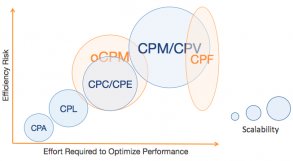CPM – payment when an ad is seen
CPM (cost per mille or thousand impressions) is the granddaddy of them all- a pricing model that existed long before the advent of the internet. Under this pricing model the publisher is paid every time a website visitor sees an ad. It’s commonly used where an advertiser wants a branding campaign; the focus is on raising consumer awareness of a company or product rather than persuading them to buy right now.
A nice easy example to start with: a website that charges a CPM of $5 will earn $5 for every 1, 000 ads that its visitors see.
CPC – payment when an ad is clicked
The interactive nature of websites allows advertisers to be more discerning about when they pay. Since the early days of the internet the ‘click’ has been used as a measure of ad effectiveness, as it indicates their interest in a product or service. The percentage of website visitors who see an ad and click it is referred to as the click-through-rate or CTR and the website is paid a cost per click (CPC) for each click on an ad. Given the CPC of an ad and its CTR we can work our way back to a CPM (sometimes referred to as an estimated CPM or eCPM). This is useful if you want to compare the performance of ad networks that use different pricing models.
eCPM = CPC * CTR * 1, 000 (because it relates to 1, 000 ads)
For example, a website that charges a CPC of $2.50 where 15 in every 10, 000 ads are clicked (CTR of 0.0015) will have an eCPM of $3.75
2.50 * 0.0015 * 1, 000 = $3.75
CPA – payment when an action is carried out
Pricing models have moved beyond the click, and it is now common for the publisher to pay a cost per user action (CPA). Affiliate advertising is a familiar application of this pricing model: the website is only paid when a website visitor clicks through an ad and completes a purchase on the advertiser’s site. Other common CPA actions include signing up to a mailing list, or a trial account with a service.
In comparison to CPC the CPA pricing model is another degree of separation away from CPM. We first estimate a CPC using the CPA and a conversion rate from clicks to actions which we call the Action Rate (AR). The AR is the percentage of visitors to the advertiser’s site who go on to complete the Action.
eCPC = CPA * AR
For example consider an advertiser who pays $10 per action (CPA) and 10% of visitors carry out the action (AR). This equates the an estimated cost per click of $1.
10 * 0.1 = $1
We can take this eCPC and convert it to an eCPM the same way as we did above. Let’s assume the same rate of 15 in every 10, 000 visitors clicks on the ad (CTR 0.0015). This yields an eCPM of $1.50






